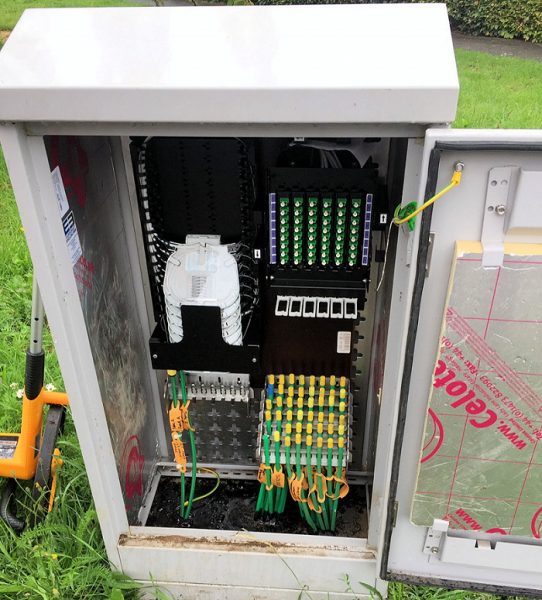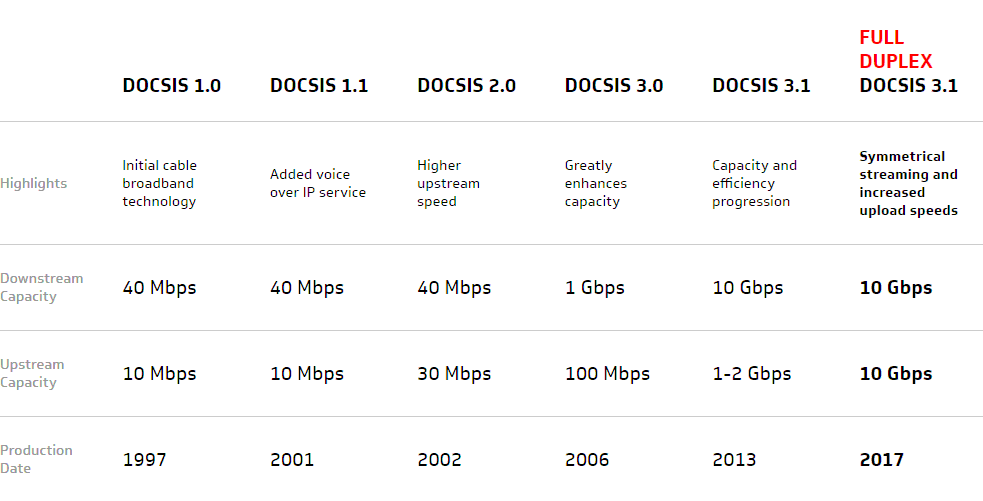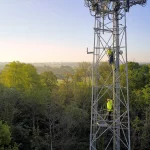Virgin Media UK Trials 2.2Gbps Broadband to Homes in Berkshire

Broadband ISP Virgin Media (Liberty Global) has announced that they’ve just successfully completed a new trial, which pushed their new DOCSIS 3.1 based network to “hyperfast” 2.2Gbps download speeds (and 214Mbps upload speeds) in the Berkshire (England) market town of Thatcham.
At present the best download speed that Virgin Media can squeeze out of their existing EuroDOCSIS 3.0 based Hybrid Fibre Coax (HFC) and Fibre-to-the-Premises (FTTP) network is about 600Mbps, although since last year they’ve also been busy working on an upgrade to gigabit-capable DOCSIS 3.1 technology – expected to cover all 15 million+ of their premises by the end of 2021 (here).
Customers of their new D3.1 based broadband package tend to pay from £62 per month for a speed of 1Gbps+ (1,140Mbps download and 50Mbps upload). Sadly, uploads are still using the old D3.0 network and thus have yet to benefit from the enhancements, although we expect this to change further down the road. So far Virgin Media have deployed their new D3.1 network to cover a total of 3.7 million homes and rising.
Advertisement
However, the D3.1 standard is theoretically capable of achieving peak downstream speeds of up to 10Gbps and 2Gbps upload, which means that Virgin Media has scope to push beyond 1Gbps in the future in order to keep pace with rival Fibre-to-the-Premises (FTTP) networks (NOTE: Ignore the reference to Full Duplex 3.1 below, that has since been rolled into DOCSIS 4.0 for the distant future).

Suffice to say that Virgin Media’s trial in the town of Thatcham made use of D3.1’s extra capability in order to achieve a download speed of 2.2Gbps, although we actually find it more interesting that they were able to hit an upload speed of 214Mbps; this would seem to indicate that they may now be applying the standard to their upstream channels too (we’re checking).
The operator also used their latest HUB 4.0 (TG3492LG-VMB / Gigabit Connect Box) router for the trial and you can see the specification for that at the bottom of this article from last year. The HUB 4.0 is VM’s only router with DOCSIS 3.1 support, although they have made the device available on some slower packages in certain areas so as to help tackle issues of high utilisation (here).
Advertisement
One slight bugbear here is that the HUB 4.0 only has 1Gbps capable LAN ports, although you can of course still harness a speed of 2.2Gbps by using multiple WiFi and LAN ports, but we’d still hope that any future 2Gbps tier ships with a more capable router.
Jeanie York, Virgin Media’s CTIO, said:
“We invest more than £1 billion into our network every year and this innovative trial demonstrates how Virgin Media’s existing future-proof cable network can deliver lightning-fast, multi-gigabit broadband speeds. We stand ready to power our customers’ connectivity needs for whatever comes next.
We’re leading the charge to make the UK faster and we’re on track for rolling out gigabit broadband speeds across our network by the end of next year. With this next-generation connectivity, our customers can experience the best from their broadband – whether that’s 8K gaming, instant streaming, high quality video calls or uploading files in a flash – all in the same home at the same time.”
As it stands, those with 1Gbps capable lines will already struggle to make use of such speeds and pumping that up to 2Gbps+, as they will no doubt do in the future, won’t make that any easier. On the other hand, as gigabit-capable lines become more common then so too will multi-gigabit broadband packages, which are set to become a necessary part of the future marketing arsenal that ISPs can bring to bear.
Being able to make such speeds available across a network of over 15 million premises (capacity allowing) will no doubt help to keep even their older HFC network competitive for a long time to come, although at present the operator has provided no indication of when a 2Gbps or faster tier might launch (we suspect they won’t do this until after the D3.1 rollout is complete).
UPDATE 10:47am
Advertisement
As expected, VM has confirmed to us that this trial did deploy D3.1 on their upstream channels for the first time.
Mark is a professional technology writer, IT consultant and computer engineer from Dorset (England), he also founded ISPreview in 1999 and enjoys analysing the latest telecoms and broadband developments. Find me on X (Twitter), Mastodon, Facebook, BlueSky, Threads.net and Linkedin.
« 18 Months of Village Broadband Disruption Traced to Old TV Set






















































That’s just teasing.
Having fast speeds is one thing, being reliable is another…
Just got let out of my contract after 3 months of reliability issues in the town, and next town over!
Wasn’t a pensioner with a dodgy tv was it?
So USO is now not quite 0.5% of the speed that will soon be available to some.
10G is available in some isolated cases.
My guess is that this will see real life as 1G/220M so a direct competitor to OR FTTP on bandwidth at least.
That way the backhaul doesn’t get too stressed.
Backhaul isn’t an issue the access network is more under pressure.
Loads of demand can be alleviated easily enough with CDNs – assuming they can still be made to work in the age of DoH et al.
I’ll be interesting to know if they used a different hub for this trial. The current HUB4 only has gigabit ethernet, so 2.2Gbps seems rather pointless.
Remember you can share that speed across multiple outputs (ports and WiFi), so while I’d agree that it’s silly to have a 1Gbps port on a multi-gigabit connection, it’s still possible to use more than 1Gbps.
Yes but for those who use it in modem mode to use their own equipment are stuck.
I’m stuck at M500 as don’t want to upgrade to the G1 package due to only get 940Mbps
Very good point.
“James ™ says:
I’m stuck at M500 as don’t want to upgrade to the G1 package due to only get 940Mbps”
Only! Some people are stuck on only a tenth of that and you’re whining!
2.2GBps yet at peak time lucky to see 100 lol
I’m on the M500 and get over 500mbps any time of day
WiFi still rubbish
So use a 3rd party router and switch to modem mode, you should be doing this anyway ALL ISP routers are garbage.
“Mark says:
ALL ISP routers are garbage.”
Not all. The Fritz!Box 7530 Zen supply is excellent. So excellent in fact that when I left Zen and transferred over to an FTTP connection with another provider I kept it as my main router, and now also use it as a DECT basestation for my ported landline via SIPGate. I’d change your ALL to “most”.
That thing is probably fine if you have DSL and don’t do any local file transfers, but I can’t see it pushing more than 300Mbps over 5GHz. That falls well within the “rubbish” category to me.
I have used Virgin Media ever since it started and have told Virgin Media via email sms even snail mail that they are just treating my area that is area 21 as second class customers as all around us in all directions have the 1gig Internet and the local engineers who work here have confirmed that we have had the infrastructure and capability of 1gig for at least 12/18 months but they will now loose a big percentage of their loyal and fed up customers because by the end of the year we get a new Internet supplier that is faster and cheaper than Virgin at 1gig up and 1gig down for the start and quick speed updates after that for £39.99 or a package at £49.99 both better than £64.99 for 1gig down and nominal up. So it’s bye bye virgin.
Can I buy some punctuation there, Bob?
In the real world people aren’t queuing up for the Gig1 product and there aren’t masses desperately waiting to cancel if it’s not immediately released.
We’re a tiny, tiny minority of customer base.
Kinda wild the real world speeds they can get out of coax for the last leg, versus DSL for the last leg. Both are just FTTC in a sense, but here we see coax with DOCSIS is competitive with FTTP.
That is because coax was designed to resit interference by acting as a wave guide. Coax is probably better than twisted pair even in ideal circumstances. However ethernet is 4 twisted pair so will probably beats coax that way.
People are very quick to get rid of copper but people forget very few homes have fiber to the end node. It’s ethernet or wifi.
@Darren Reid, thanks for that explanation, explains a lot.
The coaxial network is also amplified and has much lower loss, so can carry much higher frequencies.
VM’s network is 1.2 GHz at present and assuming they keep upgrading the next step will be at least 1.8 GHz.
G.fast gets less than 90 MHz, 0.09 GHz, FTTC 17 or so MHz. Due to no amplification and loss on the networks.
Could absolutely live with 214Mbps upload. Hoping that when they finally switch to 3.1 on the upload side of things for Gig1 that they’ll at least push it from 50Mbps to 100. 50 is really good but how do you then compete with the Openreach suppliers who’re providing people with synchronous speeds (or close to) in the near future?
It would be good if VM were to provide some information on how they did this. I presume that it was on the HFC network and that a doubling of the download speed was achieved with an additional OFDM block.
Widening the existing block would work. They can go twice as wide as the one VM deployed initially.
Does a Docsis 3.1 upstream provide any improvements with respect to jitter?
Yes, under certain conditions.
I hope so.
Here’s hoping the Hub 4 also deals with those ping spikes a lot better.
Any routers even support 2gbs? Whats the point if it doesn’t. The upload is needed though so thats good!
Both of mine do, though the lack of a cable modem with a 2.5G port on the VM side would be an issue.
My router supports 10Gbps connections, so a minority of consumers could harness the bandwidth (although not with VM due to the requirement to have they’re router/modem).
The bigger problem for me (if I were able to get a decent connection) would be upgrading my internal network above 1Gbps capability.
In reality, I’d have absolutely no need for such bandwidth. I’m currently on 50Mbps with a shoddy FTTC connection and eagerly awaiting Virgin to activate the recently installed network on my street. Then, even 500Mbps would be perfectly sufficient for the next 5 years at least.
Ok well what kind of router do you guys have? Im with virgin and i get around 560mbps download.
I personally use the UDM Pro, but as has been pointed out, I would be limited to the 1Gbps provided by the virgin router ports.
Absolutely pointless with the stupidly limited hub 4.0 with only 1gbps lan.
How many people that want this sort of speed will NOT want use modem mode and their own proper multigig router?
virgin is a thief and so is ee. why optical cables are not used ?? super fast? WHO KNOWS THAT?
Why is Virgin’s upload speed always so slow? Is it a technical limitation with how their fibre works or do they just limit uploads so they don’t need to spend as much on infrastructure whilst still offering fast download speeds?
It is a limitation of the DOCSIS standard(s) they are using.
ATM VM are moving to using 3.1 Downstream.
Generally VM are using 3.0 upstream.
The point of this trial was to show what 3.1 could achieve when used on both up & down stream.
As @MJ says in the article the real macoy has been shunted to 4.0 that hasn’t made it out if the lab as yet so won’t be seen in the wild any time soon.
It is not the standard itself, DOCSIS 3.1, but the current configuration of the HFC plant. The current return path is only 65 MHz. With some effort, 3.1 can go up to 204 MHz. Operators can easily offer 500 Mbps tiers with that. Some operators are even trialing symmetrical gigabit.
We have VM fiber in the office, and that’s 500Mbps up and down. Quite costly. I was with VM for about 20 years (in one form or another – I think it was NTL in the beginning). Unfortunately, I couldn’t get anything else in my apartment block. I was so annoyed with the painfully slow upstream that I moved to an apartment with Hyperoptic – now I have 1Gpbs up and down! In reality, I get around 800Mbps down, and about 900Mbps up, which is still fine by me. My ping times have dropped dramatically too (on VM it was always around 13ms, now it’s 1ms).
It’s just such a pity that Hyperoptic won’t wire up a building that already has Virgin Media (apparently it’s not economically viable for them, as most people don’t tend to change their ISPs for faster Internet). I felt so trapped with VM – zero choice. Now I feel liberated with Hyperoptic 🙂
We have Vodaphone gigafast which is 900/900.
Our house is using a mesh of wifi5 AP’s so each client only get around 400mbps. This limitation is actually good because if someone maxes out his wifi it doesn’t cause buffer bloat issues for everyone else. We have steering to shunt clients that hog onto a separate AP. With this setup we don’t even need to setup QoS.
I’m reluctant to enable wifi 6 as this will give full 900mb speeds and introduce buffer bloat and all the familiar symptoms of lag.
What’s needed is a consumer router that effectively manages buffet bloat and sets up QoS out of the box (no configuration required), that’s the next giant leap, not 2gbps. Nobody needs 2gbps. Unless companies start streaming 8K, bandwidth usage should start to level out. Even with 8K streams 1gbps is still way more than enough.